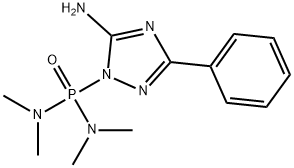TRIAMIPHOS
- CAS No.
- 1031-47-6
- Chemical Name:
- TRIAMIPHOS
- Synonyms
- wp155;wepsin;wepsyn;mide[qr];TRIAMIFOS;Triamphos;wepsyn155;wp155[qr];TRIAMIPHOS;wepsin[qr]
- CBNumber:
- CB7358623
- Molecular Formula:
- C12H19N6OP
- Molecular Weight:
- 294.29
- MDL Number:
- MFCD00055329
- MOL File:
- 1031-47-6.mol
| Melting point | 167.5°C |
|---|---|
| Boiling point | 471.7±28.0 °C(Predicted) |
| Density | 1.32±0.1 g/cm3(Predicted) |
| Flash point | 2 °C |
| storage temp. | APPROX 4°C |
| solubility | Chloroform (Slightly), DMSO (Slightly), Methanol (Slightly) |
| form | solid |
| pka | 1.67±0.50(Predicted) |
| Water Solubility | 0.25g/L(20 ºC) |
| EWG's Food Scores | 1-2 |
| FDA UNII | 9I7U4X189B |
| EPA Substance Registry System | Triamiphos (1031-47-6) |
SAFETY
Risk and Safety Statements
| Symbol(GHS) |  GHS06 |
|---|---|
| Signal word | Danger |
| Hazard statements | H300-H310 |
| Precautionary statements | P264-P270-P301+P310-P321-P330-P405-P501-P262-P264-P270-P280-P302+P350-P310-P322-P361-P363-P405-P501 |
| Hazard Codes | T+,Xn,F |
| Risk Statements | 27/28-36-20/21/22-11 |
| Safety Statements | 22-28-36/37-45-36-26-16 |
| RIDADR | 2783 |
| HazardClass | 6.1(a) |
| PackingGroup | II |
| Hazardous Substances Data | 1031-47-6(Hazardous Substances Data) |
| Toxicity | LD50 oral in rat: 20mg/kg |
TRIAMIPHOS Chemical Properties,Uses,Production
Uses
WP 155, is a pesticide that has mutagenic effect on Saccharomyces cerevisiae and Aspergillus nidulans, which was verified by comparing with standard mutagen methylmethansulfonate.
Definition
ChEBI: Triamiphos is a member of benzenes.
General Description
A solid. Used in the control of powdery mildew on apples and ornamentals. Product discontinued by U.S. supplier.
Reactivity Profile
Organophosphates, such as TRIAMIPHOS, are susceptible to formation of highly toxic and flammable phosphine gas in the presence of strong reducing agents such as hydrides. Partial oxidation by oxidizing agents may result in the release of toxic phosphorus oxides.
Health Hazard
TRIAMIPHOS is an organic phosphorus insecticide. Organic phosphorus insecticides are absorbed by the skin, as well as by the respiratory and gastrointestinal tracts. It is a cholinesterase inhibitor.
Fire Hazard
As for other organophosphorus pesticides, containers may explode in heat of fire. Heat may cause decomposition and evolution of highly toxic fumes of nitrogen oxides and phosphorus oxides.
Safety Profile
Poison by ingestion, skin contact, intraperitoneal, and possibly other routes. An experimental teratogen. Mutation data reported. When heated to decomposition it emits very toxic fumes of PO, and NOx,.





